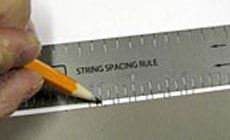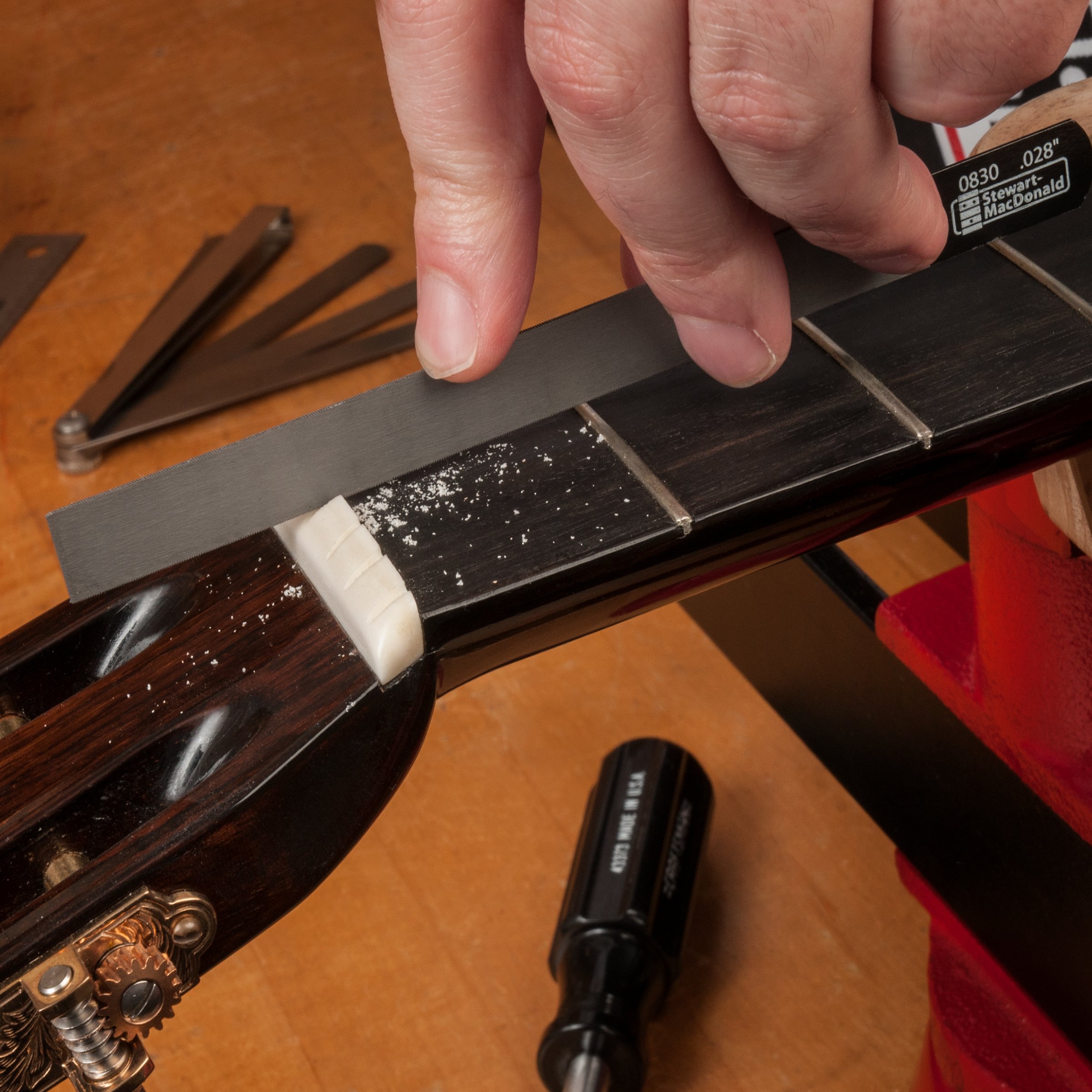Using the String Spacing Rule for guitars and mandolins
I'm finding lots of new uses for our string spacing rule. This tool isn’t just for nuts anymore! If you make six equally-spaced marks on a blank guitar nut, then cut six string slots, the heavy wound strings are going to feel a little crowded while the unwound treble strings feel gappy. That's the trouble with equal spacing: it ignores the fact that wide strings want more space than thin ones. To your eye it's subtle, but your hand feels the difference! Proportional spacing is better because it adjusts for the thickness of each string individually, moving the heavier strings apart and the narrow strings together. But how do you do the calculations to find these proportional string spaces? Kevin Ryan came up with the idea for our string spacing rule. (Kevin's a world-class luthier, with a fine eye for detail that’s helped to make his guitars famous.) The spacing rule is carefully calculated so that each step is wider than the one before. When you use it for nut slots, the bass strings get the space they need and the treble strings are also exactly right. It works with any nut, from mandolin-size to super-wide. We’re using this rule for jobs Kevin never intended: like Tune-o-matic saddles and acoustic guitar bridges. Proportional spacing is an advantage at the bridge as well as the nut — a subtle but worthwhile improvement. Kevin was surprised when told about using it for bridges: "It's amazing that I never thought of that!" said Kevin. Use the string spacing rule to locate the notches in adjustable bridge saddles. Find the overall string width by aligning the two E strings on the neck and over the pickup polepieces, then use the rule to position the other four strings. I use a tracing scribe like a miniature scratch awl to make the starter marks. Use the spacing rule to lay out acoustic bridges for new builds as well as replacement bridges for repair jobs. For a bridge replacement, you can start fresh by plugging the top and the bridge pad underneath with new round plugs of spruce. The BridgeSaver tool makes this easy, restoring the top to like-new condition so the bridge pin holes can be located exactly where they need to be. Starting with the E-to-E string spread of the original bridge, lay out correct string positions with the spacing rule. Your bass string positions will feel correct to the player, and so will the treble strings. Customers call me on our tech support line to ask whether they can use the string spacing rule for 12-string and mandolin nuts. The answer is, absolutely! Both 12-strings and mandos use paired strings. We'll refer to these as two “courses” of strings: one bass-to-treble course is paired by a second bass-to-treble course beside it. Because these courses are very close together, spacing Is especially critical on mandolins. If two wound strings are too close, they can vibrate against one another. To avoid this, here are the measurements Don MacRostie uses for nut slots on Red Diamond mandolins: Don's mando necks are 1.100" at the nut and he uses .940" overall spacing of the outside strings, centered on the nut. Starting from the outside E string, he gives the first course of strings an .831" spread. He locates the inner E 5/64" from the outer, and his second course of strings has an .862" spread (use your calipers to locate these spreads on your string spacing rule). With proportional spacing, the "G" strings at the bass side are 7/64" apart. Measure in 5/64" from the bass side edge of the fretboard, and lay out the first course of strings (.862" spread). Next, measure in 7/64" from your G string mark, and lay out your second course. For 12-string guitars, builder Todd Sams marks his spacing on an index card, then transfers the marks to the nut: Here’s an idea: the next time I custom-wind a guitar pickup, why not use proportional spacing on the polepieces, too?!Proportional String Spacing. The best string spacing for mandolins, and 12-strings, and bridge saddles, and...
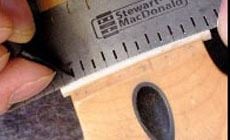
First, here’s what “proportional spacing” is about
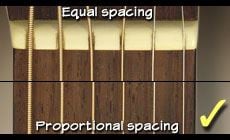
Proportional spacing made easy:


Not just for nuts: use it for bridges and saddles
Tune-o-matic bridges

Acoustic bridges

Bridge pin holes
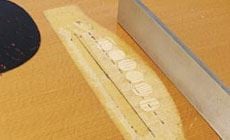

Mandolin spacing

12-string spacing

